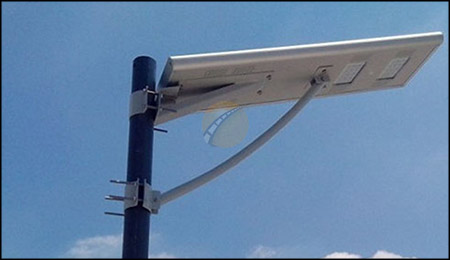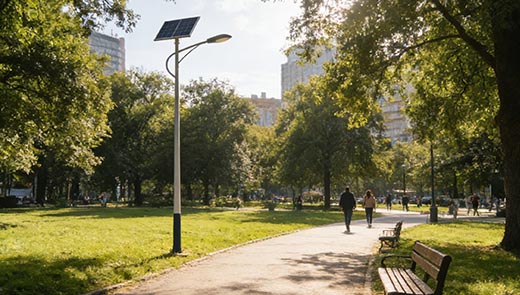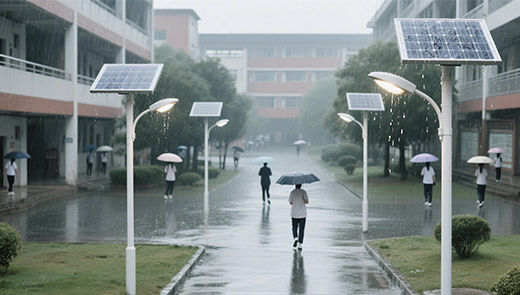What Are The Reasons That Affect The Pricing Of Solar Street Lights?
In today's context of energy saving and environmental protection, solar street lights are widely used in urban and rural road lighting by virtue of its advantages of utilizing renewable energy and reducing carbon emissions. It can not only effectively reduce the dependence on traditional electricity, but also to a certain extent to alleviate the problem of energy constraints. However, when purchasing solar street lights, people will find that their prices vary greatly. So, what exactly affects the pricing of solar street lights? In this article, we will analyze in detail the cost of materials, technical characteristics, transportation and installation costs, as well as market competition, to unravel the mystery behind the pricing of solar street lights.
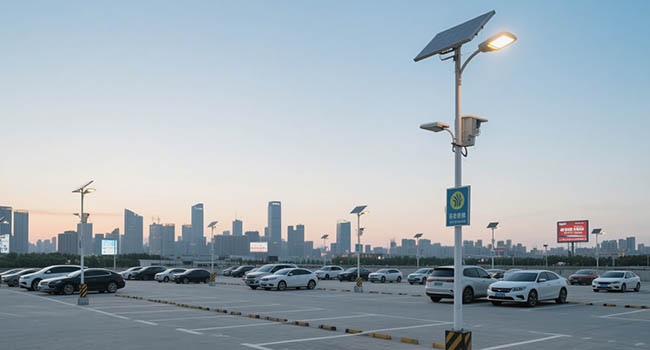
Cost of Materials
The cost of materials is one of the most critical factors affecting the pricing of solar street lights, the selection of which not only determines the price of street lights, but also directly relates to the efficiency and durability of street lights.
Photovoltaic (PV) Cells
Photovoltaic (PV) cells are the core components of solar street light power generation and play a decisive role in panel efficiency. Currently, high-quality solar cells are mostly made of silicon. High-grade silicon cells are able to absorb light more deeply and convert it into electricity more efficiently, but accordingly, they are also more expensive. This premium for high-quality silicon is directly reflected in the price of solar street light panels.
Frame Materials
The frames of solar panels are usually made of aluminum or other corrosion-resistant materials. Choosing more expensive materials can increase the durability of the panels and keep them performing well in a variety of harsh environments, but it also increases the cost of production, which in turn affects the overall price of the solar street light.
Glass and Coating
The glass that protects the PV cells needs to be strong and highly transparent to ensure maximum sunlight reception. In addition, manufacturers may apply specialized coatings to the glass that either reflect or absorb light. Among other things, high-quality anti-reflective and absorptive coatings, while improving the efficiency of light utilization, can increase the cost of production, which can drive up the price of solar street lights.
Innovative Materials
The emergence of innovative materials has brought new possibilities for solar street lights. Bendable materials can be adapted to complex installation scenarios, and transparent materials can be combined with architectural glass to realize integrated design. However, the huge R&D investment in these materials, and the high equipment and technology requirements and relatively low production efficiency of additive manufacturing and other processing processes, all of these factors add up to a significant increase in the cost of solar street lights using innovative materials, which in turn raises their market pricing.
Material Availability and Supply Chain
The availability and scarcity of materials have a significant impact on the price of solar street lights. The following are specific manifestations.
|
Influencing Factor |
Impact on Price |
|
Scarcity of Key Materials |
Increase in solar panel prices |
|
Global Supply Fluctuations of Raw Materials (e.g., Silicon) |
Affects manufacturing costs, leading to higher solar street light system prices |
Technological Features That Add Value
As technology advances, a number of advanced technological features are being applied to solar street lights that add value to the streetlight but also have an impact on its pricing.
Smart Control Systems And IoT Integration
The integration of smart control systems and IoT technology has revolutionized solar street lights, giving them unprecedented efficiency and functionality. These advanced features support remote monitoring, automatic dimming based on ambient light conditions, and even predictive maintenance capabilities. Intelligent control systems typically include sensors, microprocessors and communication modules that enable real-time data collection and analysis.
This range of advanced technologies improves energy efficiency, extends battery life, and enhances overall system performance. For larger projects or smart city initiatives, the long-term benefits of these features, such as reduced operating costs and improved city management capabilities, can justify a higher initial investment, but can also increase upfront costs.

LED Efficiency And Lighting Quality Improvements
The development of LED technology has been a milestone in the lighting industry, and solar street lights have benefited greatly from it. Efficient LEDs not only consume less energy, but also provide superior lighting quality, helping to improve safety and visibility in urban and rural environments. continued R&D in LED technology continues to push the limits of efficiency and light output, and these cutting-edge products tend to be more expensive. In addition, advances in optics and light distribution technology allow for more precise control of lighting patterns, reducing light pollution and improving the overall lighting experience.
These improvements in LED technology and lighting design enhance the value proposition of solar street lights, but are also factored into their pricing. High-quality LEDs and complex optical systems may increase initial costs, but often result in better long-term performance and user satisfaction.
Shipping And Installation Cost Factors
Costs incurred in the transportation and installation of solar street lights from production to commissioning are also important factors in their final pricing.
Logistical Challenges In Transportation
Transporting solar street lights from the manufacturing plant to the installation site, especially for large projects or remote locations, can significantly affect their final cost. The size and weight of solar panels, batteries and poles present unique logistical challenges that increase transportation costs. Special packaging requirements to protect sensitive components from damage during transportation also add further to the total cost. For projects in countries that do not have domestic solar streetlight production capacity, international transportation, tariffs, and import taxes can also have an impact on pricing.
Coordinating the delivery of multi-component systems and possible delays due to customs clearance procedures can affect project schedules and costs. Therefore, the geographic location of the installation site and the associated transportation logistics become a key factor in determining the final price of a solar streetlight solution.
On-Site Installation Complexities
The installation of solar street lights is more than just erecting poles and mounting fixtures. It requires careful site assessment, ground preparation, and often specialized equipment to install the solar panels and batteries.The complexity of the installation can vary greatly depending on factors such as soil conditions, topography and local regulations. In urban environments, working around existing infrastructure and minimizing disruption to traffic and pedestrians can add to the difficulty and cost of installation.
In addition, skilled technicians are required to properly set up and calibrate solar streetlight systems, which adds to the overall cost. This is especially true for advanced systems that have smart features or require integration with existing city management systems. Costs associated with training local maintenance staff or providing ongoing technical support should also be considered when evaluating the total investment in a solar streetlight project.
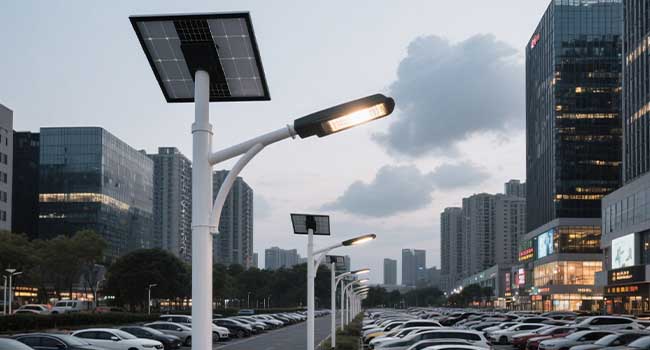
Market Competition
The state of market competition largely influences the pricing strategy of solar street lights, and different competitive tactics can lead to different price variations.
Innovative Product Designs
In an already mature market environment, solar street light manufacturers strive to innovate in unique designs to stand out. These innovative designs sometimes lead to better performance, longer life and higher operability.
For example, innovations may include improved solar panels that use less silicon yet produce more energy, better battery technology, or designs that are easier to install and maintain. These advances may lead to higher costs in the short term, but as these technologies are adopted by more manufacturers, a general trend toward lower costs usually emerges.
Competitive Pricing
Due to the highly competitive nature of the industry, suppliers tend to adopt predatory pricing strategies. This usually means that in order to secure contracts with municipalities, businesses, and other entities, suppliers will often bid below cost or offer concessions such as volume discounts and more lenient payment terms.
Of course, the solar street lighting industry may not be in that bad of shape yet, but this downward pressure on prices is really benefiting consumers by bringing actual system prices down.
Value-Added Services
Many manufacturers and suppliers differentiate their offerings by providing services such as installation, maintenance or extended warranties. While these services add first-class value to customers, they also have an impact on the price of solar street lights. Sometimes these services are included in the price, while in other cases they are optional add-ons. Additionally, the need for lower prices in some markets can drive better overall value propositions from suppliers in highly competitive regions.
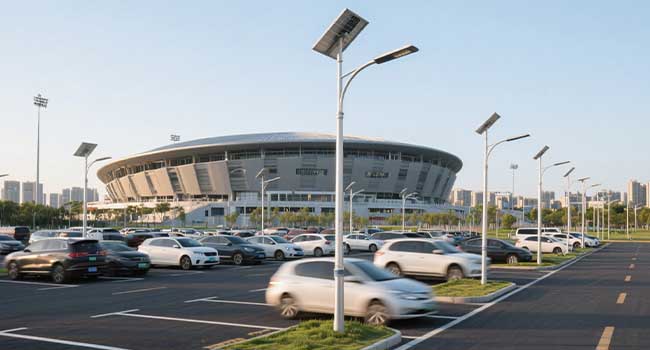
Supplier Differentiation
In highly competitive markets, suppliers not only try to reduce costs, but also differentiate themselves from their competitors through better customer service, faster delivery times, and more extensive warranties. These factors influence the total cost structure and may drive buyers to choose one supplier over another, affecting the price of each solar street light panel.
Market Penetration Strategies
In a highly competitive market, new entrants may use penetration pricing strategies to intentionally lower the price of their products in an effort to gain business quickly. This aggressive pricing strategy will effectively lower the price of solar street light panels across the industry, as incumbents will react and defend their market share at all costs.
The pricing of solar street lights is the result of a combination of factors such as material costs, technical characteristics, transportation and installation, and market competition. These factors are as much about product quality and performance as they are about supply chain stability and investment in technological innovation. Understanding these influencing factors will help purchasers make more reasonable choices according to actual needs and budgets, and find the best balance between costs and benefits.

